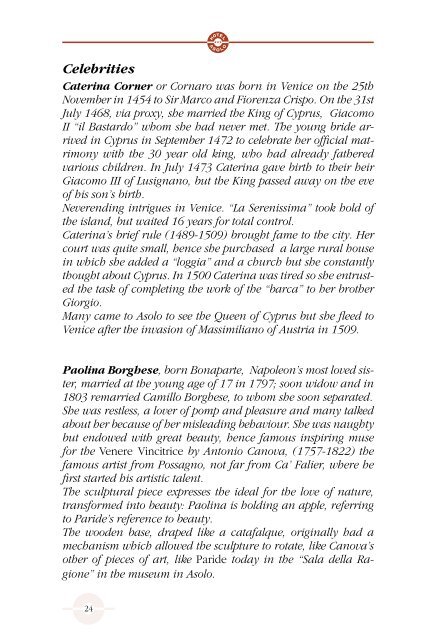Create successful ePaper yourself
Turn your PDF publications into a flip-book with our unique Google optimized e-Paper software.
Celebrities<br />
Caterina Corner or Cornaro was born in Venice on the 25th<br />
November in 1454 to Sir Marco and Fiorenza Crispo. On the 31st<br />
July 1468, via proxy, she married the King of Cyprus, Giacomo<br />
II “il Bastardo” whom she had never met. The young bride arrived<br />
in Cyprus in September 1472 to celebrate her official matrimony<br />
with the 30 year old king, who had already fathered<br />
various children. In July 1473 Caterina gave birth to their heir<br />
Giacomo III of Lusignano, but the King passed away on the eve<br />
of his son’s birth.<br />
Neverending intrigues in Venice. “La Serenissima” took hold of<br />
the island, but waited 16 years for total control.<br />
Caterina’s brief rule (1489-1509) brought fame to the city. Her<br />
court was quite small, hence she purchased a large rural house<br />
in which she added a “loggia” and a church but she constantly<br />
thought about Cyprus. In 1500 Caterina was tired so she entrusted<br />
the task of completing the work of the “barca” to her brother<br />
Giorgio.<br />
Many came to <strong>Asolo</strong> to see the Queen of Cyprus but she fleed to<br />
Venice after the invasion of Massimiliano of Austria in 1509.<br />
Paolina Borghese, born Bonaparte, Napoleon’s most loved sister,<br />
married at the young age of 17 in 1797; soon widow and in<br />
1803 remarried Camillo Borghese, to whom she soon separated.<br />
She was restless, a lover of pomp and pleasure and many talked<br />
about her because of her misleading behaviour. She was naughty<br />
but endowed with great beauty, hence famous inspiring muse<br />
for the Venere Vincitrice by Antonio Canova, (1757-1822) the<br />
famous artist from Possagno, not far from Ca’ Falier, where he<br />
first started his artistic talent.<br />
The sculptural piece expresses the ideal for the love of nature,<br />
transformed into beauty: Paolina is holding an apple, referring<br />
to Paride’s reference to beauty.<br />
The wooden base, draped like a catafalque, originally had a<br />
mechanism which allowed the sculpture to rotate, like Canova’s<br />
other of pieces of art, like Paride today in the “Sala della Ragione”<br />
in the museum in <strong>Asolo</strong>.<br />
24


